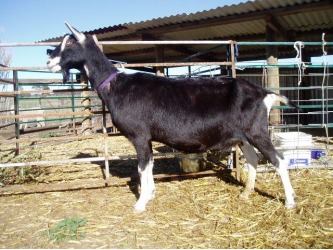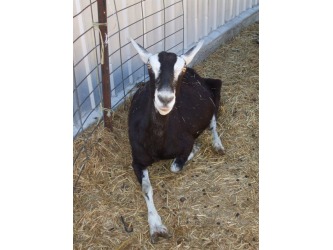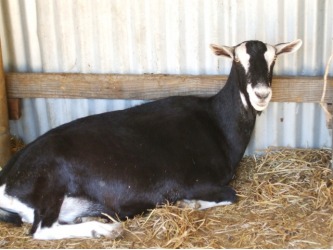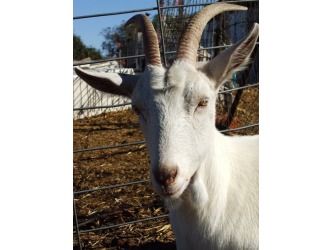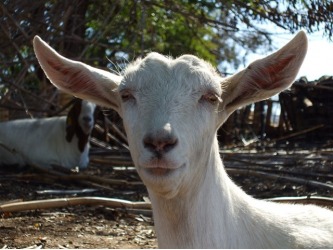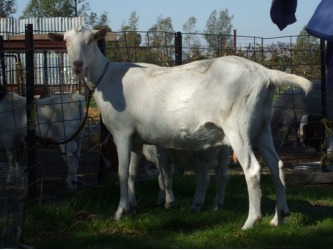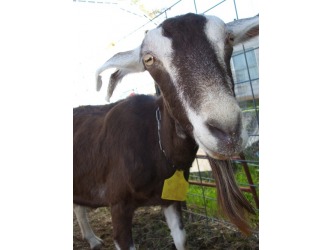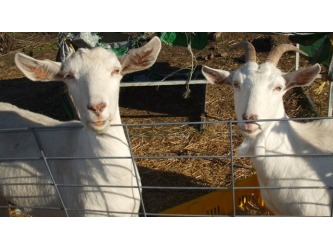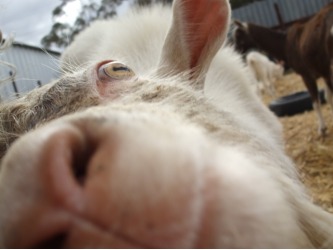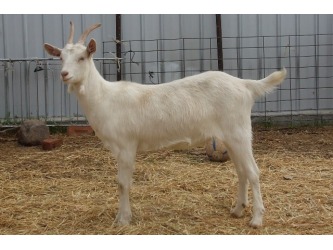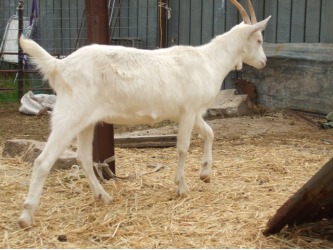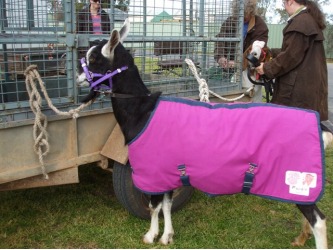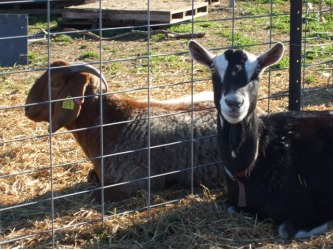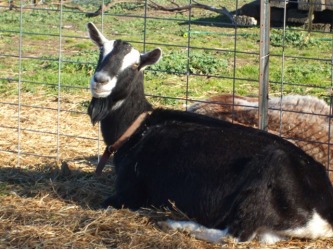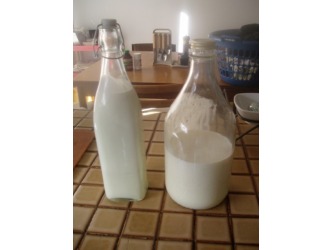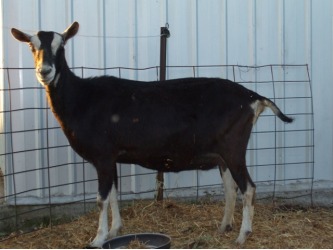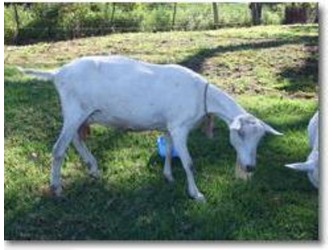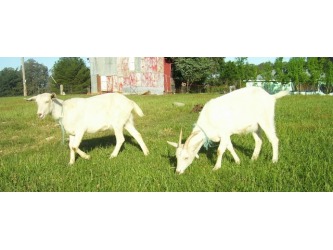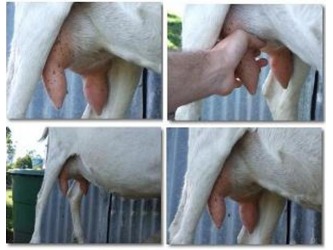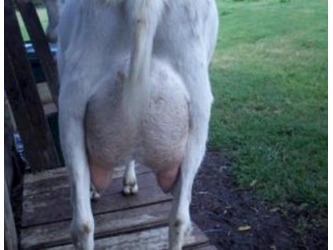Pacqio stud is pleased to announce that we will be concentrating on developing a small herd of show quality dairy goats over the next two years, while the rest of our animals are on lease.
The Dairy Goat
There are six main breeds of dairy goat in Australia: the three Swiss breeds - Saanen, British Alpine and Toggenburg; the Australian breeds - Australian Meelan and Australian Brown; and the Anglo Nubian.
Each breed has its own characteristics, benefits and drawbacks. Each breed has a characteristic coat colour and pattern, which is often what draws people to one breed over another. We are slowly building our herd to include all of the dairy breeds, recognising that each breed has its own benefits it can bring to our herd; as well as acknowledging that everyone is looking for something different for their home milker. At the end of the day, we aim to breed the best goats we can, with show ring type and high milk production, regardless of the breed.
At this stage we have mainly British Alpines; they are renowned for their extended lactations, being able to produce good quantities of milk for two years without re-breeding. This is an advantageous trait for family milkers as the owner does not need to take the doe to a suitable buck every year, or keep their own buck. The British Alpine is the largest of all dairy breeds and more suited than some to being kept in larger paddocks, on pasture. However, we have found they do equally well in confinement, on a grain and hay diet. They should produce approximately 4L of milk or more per day; the milk from the British Alpine is very creamy and sweet tasting.
Saanen does also make up a large portion of our herd; this breed is known for its high level of production, easily producing 4L of milk per day or even more. Well bred show does can produce 8 L of milk per day. The milk from the Saanen is somewhere in between full fat milk and skim milk; this is the reason we have Saanens - milk that is healthier than the full fat we receive from the British Alpine, while being tastier than true skim milk. Saanen milk is very suitable for people who, for health reasons, require low fat milk; my father who has diabetes is a good example.
Goat's milk can often be consumed by people who aren't able to drink cow's milk, due to digestive upsets. Goat's milk has the same level of lactose as cow's milk, however that lactose is formulated slightly differently and as such it is easier to digest for lactose intolerant people. Goat's milk also has a different protein to cow's milk, making it suitable for people who are allergic to the protein in cow's milk. My sister and her two children are lactose intolerant and suffer severe stomach pain and diarrhoea from cow's milk; however they are not affected by goat's milk.
Each breed has its own characteristics, benefits and drawbacks. Each breed has a characteristic coat colour and pattern, which is often what draws people to one breed over another. We are slowly building our herd to include all of the dairy breeds, recognising that each breed has its own benefits it can bring to our herd; as well as acknowledging that everyone is looking for something different for their home milker. At the end of the day, we aim to breed the best goats we can, with show ring type and high milk production, regardless of the breed.
At this stage we have mainly British Alpines; they are renowned for their extended lactations, being able to produce good quantities of milk for two years without re-breeding. This is an advantageous trait for family milkers as the owner does not need to take the doe to a suitable buck every year, or keep their own buck. The British Alpine is the largest of all dairy breeds and more suited than some to being kept in larger paddocks, on pasture. However, we have found they do equally well in confinement, on a grain and hay diet. They should produce approximately 4L of milk or more per day; the milk from the British Alpine is very creamy and sweet tasting.
Saanen does also make up a large portion of our herd; this breed is known for its high level of production, easily producing 4L of milk per day or even more. Well bred show does can produce 8 L of milk per day. The milk from the Saanen is somewhere in between full fat milk and skim milk; this is the reason we have Saanens - milk that is healthier than the full fat we receive from the British Alpine, while being tastier than true skim milk. Saanen milk is very suitable for people who, for health reasons, require low fat milk; my father who has diabetes is a good example.
Goat's milk can often be consumed by people who aren't able to drink cow's milk, due to digestive upsets. Goat's milk has the same level of lactose as cow's milk, however that lactose is formulated slightly differently and as such it is easier to digest for lactose intolerant people. Goat's milk also has a different protein to cow's milk, making it suitable for people who are allergic to the protein in cow's milk. My sister and her two children are lactose intolerant and suffer severe stomach pain and diarrhoea from cow's milk; however they are not affected by goat's milk.
Breeding Objective
We believe that the ideal goat is one which has correct conformation as to be show ring TYPE, along with high milk PRODUCTION. We do not believe there should be a difference between 'show goats' and 'milk goats'.
We aim to produce friendly, people orientated does which make good family milkers; does which produce at least 4L of milk per day for at least 300 days of lactation. Udders must be strongly attached so that they will not break down as the animal ages. Teats need to be reasonable sized for easy hand milking, with orifices that allow quick milking. Animals must be well behaved and allow various different people to milk them. And of course we do not forget structural soundness.
We aim to produce friendly, people orientated does which make good family milkers; does which produce at least 4L of milk per day for at least 300 days of lactation. Udders must be strongly attached so that they will not break down as the animal ages. Teats need to be reasonable sized for easy hand milking, with orifices that allow quick milking. Animals must be well behaved and allow various different people to milk them. And of course we do not forget structural soundness.
